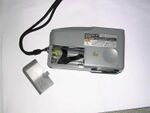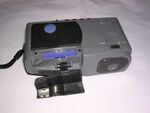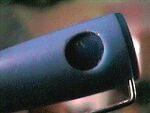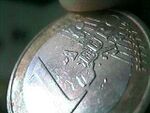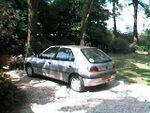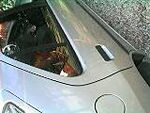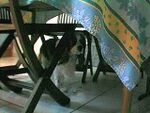Difference between revisions of "Digio SJ-1"
From Sega Retro
Scarred Sun (talk | contribs) (New page: The '''Sega Digio SJ-1''' is an early LCD digital camera manufactured by Sega. It was introduced to the Japanese market in 1995 with an updated version featuring a viewfinder in 1996. ...) |
|||
| (23 intermediate revisions by 4 users not shown) | |||
| Line 1: | Line 1: | ||
| − | The '''Sega Digio SJ-1''' is an early LCD digital camera manufactured by [[Sega]]. It was introduced to the Japanese market in 1995 with an updated version featuring a viewfinder in 1996. This updated version was also produced for the Australian market. | + | {{ConsoleBob |
| + | | logo=Digio SJ-1 Logo.png | ||
| + | | consoleimage=digio_pack3.jpg | ||
| + | | name= | ||
| + | | maker=[[Sega]] | ||
| + | | internal_games= | ||
| + | | releases={{releasesMisc | ||
| + | | misc_date_jp=1995 | ||
| + | | misc_date_jp_1=1996 | ||
| + | | misc_type_jp_1=Viewfinder | ||
| + | | misc_date_jp_2=199x | ||
| + | | misc_type_jp_2=Java Tea | ||
| + | | misc_date_jp_3=199x | ||
| + | | misc_type_jp_3=Le Coq Sportif | ||
| + | | misc_date_au=199x | ||
| + | }} | ||
| + | }} | ||
| + | The '''Sega Digio SJ-1''' (デジオ) is an early LCD digital camera manufactured by [[Sega]]. It was introduced to the Japanese market in 1995 with an updated version featuring a viewfinder in 1996. This updated version was also produced for the Australian market. | ||
| + | ==Hardware== | ||
The Digio has a sensor of 320x240 pixels and takes pictures in two resolutions: 320x240 and 160x120. The image files are in .SJ1 format, which can only be read with the software that comes with it. The SmartMedia card that comes with the Digio is 5Mbit (640KB) and can store approx 20 pictures in "high quality." There is no AutoFocus, but there is a manual focus that can even do macro-level focusing. Fortunately, there is an automatic aperture/luminosity feature that works reasonably well. In addition, there is no digital zoom available for the camera. The Digio requires 4 AA batteries for operation; from a connection point of view, there are three outputs: one for DC10V (+ center), one for Video Composite Output and one for Serial communication (to the computer or another Digio.) | The Digio has a sensor of 320x240 pixels and takes pictures in two resolutions: 320x240 and 160x120. The image files are in .SJ1 format, which can only be read with the software that comes with it. The SmartMedia card that comes with the Digio is 5Mbit (640KB) and can store approx 20 pictures in "high quality." There is no AutoFocus, but there is a manual focus that can even do macro-level focusing. Fortunately, there is an automatic aperture/luminosity feature that works reasonably well. In addition, there is no digital zoom available for the camera. The Digio requires 4 AA batteries for operation; from a connection point of view, there are three outputs: one for DC10V (+ center), one for Video Composite Output and one for Serial communication (to the computer or another Digio.) | ||
The Digio starts up within 2 seconds, showing a cool title screen during INIT process, and takes approximately 2-5 seconds to save/view one shot. There is a timer, a view mode and an erase/format disc menu. | The Digio starts up within 2 seconds, showing a cool title screen during INIT process, and takes approximately 2-5 seconds to save/view one shot. There is a timer, a view mode and an erase/format disc menu. | ||
| − | The computer software (that uses the COM1 or 2) is in Japanese but works well on Windows 98SE. You can open, rename, or delete your pics directly linked to the DigiCam. There are some tools to edit pictures and one export mode (in BMP or TIFF). The Digio may also be used in conjunction with [[ | + | The computer software (that uses the COM1 or 2) is in Japanese but works well on Windows 98SE. You can open, rename, or delete your pics directly linked to the DigiCam. There are some tools to edit pictures and one export mode (in BMP or TIFF). The Digio may also be used in conjunction with a [[Picture Magic]] to edit photos and can also be linked to ''[[Print Club]]'' machines. According to archived{{ref|https://web.archive.org/web/19970215221511/http://www.sega.co.jp:80/sega/athome/toys/digio/digio.html}} web pages, connectivity with the [[Sega Saturn]] was also planned and even advertised, though it's not known if it ever was implemented. |
| − | [[Category: | + | Two special versions of the Digio are known to exist; a Java Tea-sponsored edition released to help promote ''[[Virtua Fighter 3]]'', and a Le Coq Sportif variant, the details of which are not known. |
| + | |||
| + | ==Hardware== | ||
| + | <gallery widths="150"> | ||
| + | Image:digio_pack0.jpg|Contents of Digio retail package | ||
| + | Image:digio_pack1.jpg|Instruction manuals and diskette | ||
| + | Image:digio_pack2.jpg|Digio inside box | ||
| + | Image:digio_pack4.jpg|Battery compartment | ||
| + | Image:digio_pack5.jpg|Top view with all buttons viewable | ||
| + | Digio SJ-1 4Mbit SmartMedia Card (Digital Film SSFDS).jpg|Digio 4Mbit SmartMedia Card | ||
| + | Digio SJ-1(Alt).jpg|Digio SJ-1 | ||
| + | Digio Front.jpg | ||
| + | Digio Top.jpg | ||
| + | PCSetsuzokuKit PC JP Box Front HDC3000.jpg|PC Setsuzoku Kit (PC接続キット) | ||
| + | PCSetsuzokuKit Digio JP Box Front HDC3002.jpg|PC Setsuzoku Kit (PC接続キット) | ||
| + | </gallery> | ||
| + | |||
| + | ==Digio Pictures== | ||
| + | The following are example images taken with a Sega Digio SJ-1 camera to show the quality of pictures created by the camera. | ||
| + | |||
| + | <gallery widths="150"> | ||
| + | Image:digio_pic0.jpg | ||
| + | Image:digio_pic1.jpg | ||
| + | Image:digio_pic2.jpg | ||
| + | Image:digio_pic3.jpg | ||
| + | Image:digio_pic4.jpg | ||
| + | Image:digio_pic5.jpg | ||
| + | </gallery> | ||
| + | |||
| + | ==Magazine articles== | ||
| + | {{mainArticle|{{PAGENAME}}/Magazine articles}} | ||
| + | |||
| + | ==Physical scans== | ||
| + | {{Scanbox | ||
| + | | console=Digio | ||
| + | | region=JP | ||
| + | | front=digio_packfull.jpg | ||
| + | | back= | ||
| + | | square=yes | ||
| + | }} | ||
| + | |||
| + | |||
| + | ==References== | ||
| + | <references /> | ||
| + | |||
| + | [[Category:Consumer products]] | ||
Revision as of 02:25, 27 July 2020

| |||||||||||||||||||||||||

| |||||||||||||||||||||||||
| Digio SJ-1 | |||||||||||||||||||||||||
|---|---|---|---|---|---|---|---|---|---|---|---|---|---|---|---|---|---|---|---|---|---|---|---|---|---|
| Manufacturer: Sega | |||||||||||||||||||||||||
|
The Sega Digio SJ-1 (デジオ) is an early LCD digital camera manufactured by Sega. It was introduced to the Japanese market in 1995 with an updated version featuring a viewfinder in 1996. This updated version was also produced for the Australian market.
Hardware
The Digio has a sensor of 320x240 pixels and takes pictures in two resolutions: 320x240 and 160x120. The image files are in .SJ1 format, which can only be read with the software that comes with it. The SmartMedia card that comes with the Digio is 5Mbit (640KB) and can store approx 20 pictures in "high quality." There is no AutoFocus, but there is a manual focus that can even do macro-level focusing. Fortunately, there is an automatic aperture/luminosity feature that works reasonably well. In addition, there is no digital zoom available for the camera. The Digio requires 4 AA batteries for operation; from a connection point of view, there are three outputs: one for DC10V (+ center), one for Video Composite Output and one for Serial communication (to the computer or another Digio.)
The Digio starts up within 2 seconds, showing a cool title screen during INIT process, and takes approximately 2-5 seconds to save/view one shot. There is a timer, a view mode and an erase/format disc menu.
The computer software (that uses the COM1 or 2) is in Japanese but works well on Windows 98SE. You can open, rename, or delete your pics directly linked to the DigiCam. There are some tools to edit pictures and one export mode (in BMP or TIFF). The Digio may also be used in conjunction with a Picture Magic to edit photos and can also be linked to Print Club machines. According to archived[1] web pages, connectivity with the Sega Saturn was also planned and even advertised, though it's not known if it ever was implemented.
Two special versions of the Digio are known to exist; a Java Tea-sponsored edition released to help promote Virtua Fighter 3, and a Le Coq Sportif variant, the details of which are not known.
Hardware
Digio Pictures
The following are example images taken with a Sega Digio SJ-1 camera to show the quality of pictures created by the camera.
Magazine articles
- Main article: Digio SJ-1/Magazine articles.
Physical scans
References
- ↑ http://www.sega.co.jp:80/sega/athome/toys/digio/digio.html (Wayback Machine: 1997-02-15 22:15)



